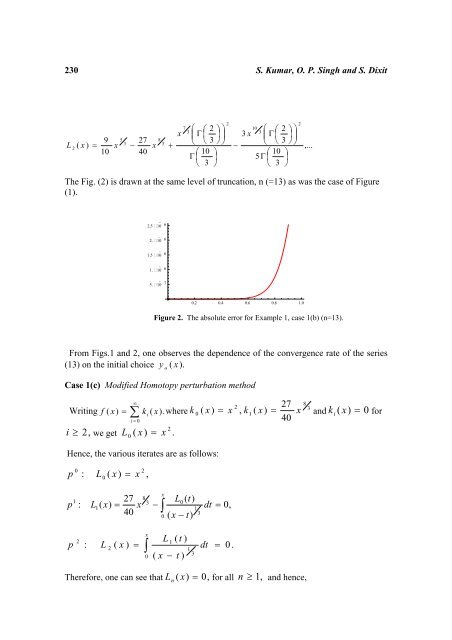An Analytic Algorithm for Generalized Abel Integral Equation
An Analytic Algorithm for Generalized Abel Integral Equation
An Analytic Algorithm for Generalized Abel Integral Equation
You also want an ePaper? Increase the reach of your titles
YUMPU automatically turns print PDFs into web optimized ePapers that Google loves.
230 S. Kumar, O. P. Singh and S. Dixit<br />
L ( x ) =<br />
2<br />
9<br />
10<br />
x<br />
5<br />
3<br />
−<br />
27<br />
40<br />
x<br />
8<br />
3<br />
+<br />
x<br />
⎛ ⎛ 2<br />
⎜ Γ ⎜<br />
⎝ ⎝ 3<br />
⎛ 10 ⎞<br />
Γ ⎜ ⎟<br />
⎝ 3 ⎠<br />
7<br />
3<br />
⎞ ⎞<br />
⎟ ⎟<br />
⎠ ⎠<br />
2<br />
10 ⎛ 2<br />
3 ⎛ ⎞ ⎞<br />
3 x ⎜ Γ ⎜ ⎟ ⎟<br />
⎝ ⎝ 3 ⎠<br />
−<br />
⎠<br />
⎛ 10 ⎞<br />
5 Γ ⎜ ⎟<br />
⎝ 3 ⎠<br />
The Fig. (2) is drawn at the same level of truncation, n (=13) as was the case of Figure<br />
(1).<br />
2.5 10� 6<br />
2. 10� 6<br />
1.5 10� 6<br />
1. 10� 6<br />
5. 10� 7<br />
0.2 0.4 0.6 0.8 1.0<br />
Figure 2. The absolute error <strong>for</strong> Example 1, case 1(b) (n=13).<br />
From Figs.1 and 2, one observes the dependence of the convergence rate of the series<br />
(13) on the initial choice ( x).<br />
y o<br />
Case 1(c) Modified Homotopy perturbation method<br />
Writing ( ) ∑ ( ) .<br />
0<br />
∞<br />
2<br />
f x = k i x where k 0 ( x ) = x , k 1 ( x ) =<br />
i =<br />
27<br />
40<br />
8<br />
3 x and k i ( x)<br />
= 0 <strong>for</strong><br />
i ≥ 2,<br />
we get L<br />
2<br />
( x ) = x .<br />
0<br />
Hence, the various iterates are as follows:<br />
0<br />
p : L ( x ) = x<br />
p<br />
p<br />
1<br />
2<br />
:<br />
:<br />
0<br />
L ( x)<br />
=<br />
1<br />
L<br />
2<br />
27<br />
40<br />
x<br />
( x ) =<br />
2<br />
,<br />
8<br />
3<br />
x<br />
∫<br />
0<br />
−<br />
x<br />
∫<br />
0<br />
L<br />
L ( t)<br />
0<br />
( x − t)<br />
1<br />
( t )<br />
( x − t )<br />
1<br />
3<br />
There<strong>for</strong>e, one can see that Ln ( x)<br />
= 0,<br />
<strong>for</strong> all n ≥ 1,<br />
and hence,<br />
1<br />
3<br />
dt<br />
dt<br />
=<br />
=<br />
0,<br />
0 .<br />
2<br />
,...

















